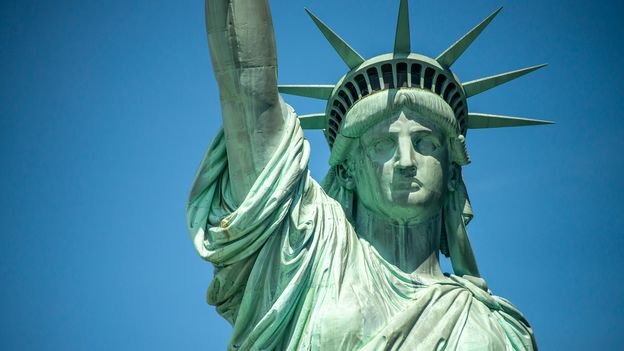The contested work is currently on display at New York’s Whitney Museum as part of Sherald’s touring exhibition American Sublime and is characteristic of the artist’s instinct to dislocate her subjects and unsettle expectations. Sherald often achieves this, as she does both in her portrait of Obama and in Trans Forming Liberty, by translating her subjects’ complexions into an uncanny greyscale (or “grisaille”), nudging viewers to look past skin colour and reassess their assumptions about what constitutes race. The model for Sherald’s work, Arewà Basit, a black artist who identifies as non-binary trans-femme, is portrayed against a flat, periwinkle background, hand on hips, wearing a vibrant ultramarine gown that recalls the otherworldly resplendence of Renaissance Madonnas, and neon fuschia hair.
The torch she lifts has been supplanted by a clutch of humble Gerbera daisies, traditionally a symbol of joy and hope – a subtle subversion that faintly calls to mind the disarming weapon wielded by Banksy’s Flower Thrower, who too is powerful in his powerlessness. Of the intended potency of her own work, Sherald has explained that her painting “exists to hold space for someone whose humanity has been politicised and disregarded” – a sentiment that arguably rhymes with the hospitable spirit of the statue itself, which is famously affixed with a sonnet by Emma Lazarus, summoning “homeless, tempest-tossed” “masses yearning to breathe free”.
A polarising symbol
That synchronicity, however, may be both the painting’s profoundest allure and deepest liability. From the moment the statue was unveiled in October 1886, it provoked criticism from both ends of the political spectrum. Suffragettes insisted the sculpture’s depiction of a woman embodying liberty was too ironic to be taken seriously when women themselves were denied the right to vote. At the same time, conservatives objected to any incitement of migrants to flock to the US – those “huddled masses” the sculpture silently summons. By recasting Lady Liberty as a totem of unfulfilled promise, Sherald’s work aims to send a tremor down the fault-line of the American conscience.

